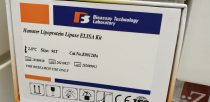The present coronavirus illness of 2019 (COVID-19) pandemic, brought on by the extreme acute respiratory syndrome coronavirus (SARS-CoV)-2, has spurred a wave of analysis of practically unprecedented scale. […]
Raw Cow Milk Bacterial Consortium as Bioindicator of Circulating Anti-Microbial Resistance (AMR)
The setting, together with animals and animal merchandise, is colonized by bacterial species which are typical and particular of each totally different ecological area of interest. Natural and […]
Use of Hybrid Data-Dependent and -Independent Acquisition Spectral Libraries Empowers Dual-Proteome Profiling
In the context of bacterial infections, it’s crucial that physiological responses could be studied in an built-in method, which means a simultaneous evaluation of each the host and […]
Human pores and skin is composed of the cell-rich dermis, the extracellular matrix (ECM) wealthy dermis, and the hypodermis.
Within the dermis, a dense community of ECM proteins offers structural assist to the pores and skin and regulates a large variety of signaling pathways which govern cell […]
Mass-spectrometry-based proteomic correlates of grade and stage reveal pathways and kinases associated with aggressive human cancers
Proteomic signatures associated with medical measures of extra aggressive cancers may yield molecular clues as to illness drivers. Here, using the Clinical Proteomic Tumor Analysis Consortium (CPTAC) mass-spectrometry-based proteomics datasets, we outlined differentially expressed proteins […]
An Update on MRMAssayDB: A Comprehensive Resource for Targeted Proteomics Assays in the Community
Precise multiplexed quantification of proteins in organic samples will be achieved by focused proteomics utilizing a number of or parallel response monitoring (MRM/PRM). Combined with inside requirements, the methodology achieves […]
A publication enhances secretion and agonist OX40L antibody that stimulates T cell proliferation. OX40 is localized to and propagates the immune response by boosting survival and division of T-cells, thus increasing the inhabitants of memory CD4 and CD8 T cells generated in response. The OX40/OX40L suppress the action of cells and can modulate production. OX40/OX40L is a significant mediator of the reaction. Past studies have indicated that OX40 signaling involved with the progression of autoimmune diseases. OX40L (CD252), a membrane-bound member of the tumor necrosis factor superfamily, is regarded as an essential co-stimulatory molecule through immune reaction. With this antibody, we discovered that OX40L was transiently upregulated on CD4(+) T cells during the first phase of regeneration. Cross-linking of OX40L with antibody boosted regeneration and improved cytokine production and T cell proliferation, demonstrating that a signal was conducted by OX40L . OX40L can play a significant function in the early stage of proliferation and T cell activation.
OX40 is also referred to as CD134 is a part of the tumor necrosis factor receptor superfamily (TNFR). Binding to its ligand, OX40L offers sign to effector T-cells with no activation.
Catalog Number: 445-90681
Category: Antibody
Supplier: Chondrex
To order Chonblock Detection Antibody Dilution from Chondrex Contact info@proteomeconsortium.org
Catalog Number: 451-AS10 1136
Category: Antibody
Supplier: Agrisera
Species: Goat
To order Goat Anti Rat IgG H&L Fitc Conjugated from Agrisera Contact info@proteomeconsortium.org
Catalog Number: 399-CSB-PA006176LC
Category: Antibody
Supplier: Cusabio
Species: Human – Rabbit
To order Rabbit Anti Human Ctps1 Antibody Fitc from Cusabio Contact info@proteomeconsortium.org






